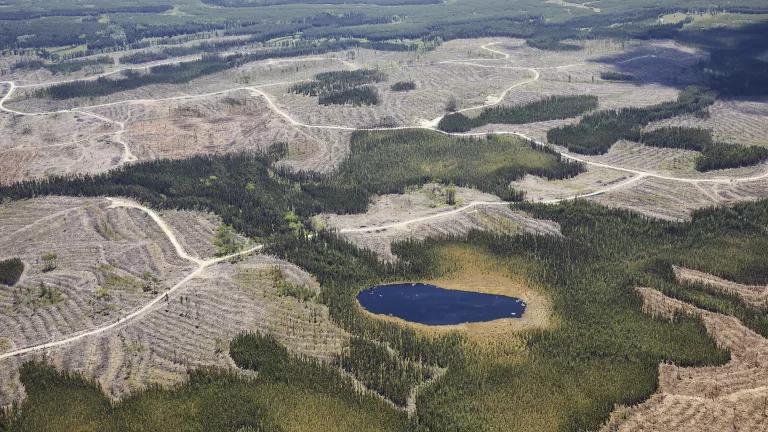Establishing a National Healthy Riverscapes Initiative
NRDC is advocating for policies to protect and restore wetlands, increase public investment in nature-based solutions, and strengthen our natural infrastructure.

An aerial view of a healthy riverscape on Blackrock Creek in Bridger-Teton National Forest, Wyoming
© Joe Wheaton, CC BY 4.0
In the United States, more than 640 million acres of federal land are managed for public benefit. National forests, wildlife refuges, national parks, and other conservation lands provide myriad benefits to people and wildlife, including clean drinking water for millions of Americans, recreation opportunities, and habitat. In addition, some lands are managed for timber, energy production, and livestock grazing. As we learn more about—and live through—the challenges that come with climate change and biodiversity loss, we are forced to think anew about how we prioritize management outcomes on public lands and invest in our shared natural assets, including our riverscapes.
Riverscapes are stream or river habitats with their associated floodplains, wetlands, and riparian vegetation. When they are healthy, riverscapes and their associated wetlands are critical natural infrastructure that support biodiversity, slow the flow of water, attenuate flooding, and act as fire breaks and refuges where wildlife can shelter from harmful conditions. Unfortunately, most riverscapes are a tiny remnant of their former footprints on the landscape and are no longer providing meaningful habitat or regulating the filtering and flow of water as we need them to do.
The Bureau of Land Management, National Park Service, U.S. Fish & Wildlife Service, and U.S. Forest Service are responsible for maintaining and restoring the wetlands and rivers under their jurisdiction. To best deliver on this responsibility, federal agencies should work together to develop a national healthy riverscapes initiative to improve and expand aquatic habitat across public lands and work in partnership with tribes and private landowners interested in achieving similar outcomes. A national initiative should prioritize investment in simple and cost-efficient restoration projects that mimic natural systems, including low-tech, process-based restoration, such as the practice of using beaver dam mimicry, wood, and other natural materials to slow flows, widen stream channels, and trap stream sediment to begin the process of moving water back onto the floodplain and recharging groundwater. By concentrating on these techniques, federal land managers can dramatically improve the acreage, complexity, and structure of riparian systems, and lay the groundwork for an enduring, healthy riverscape initiative across the country. Furthermore, once natural processes are kick-started, beavers can return naturally or be translocated to such streams to inexpensively sustain and expand riverscape restoration.
These techniques can restore hydrologic function, turning degraded stream channels into healthy, functioning riverscapes that yield greater and more consistent benefits in water quantity, water quality, habitat, and movement corridors for terrestrial and aquatic species, recreation, and carbon sequestration, all while increasing community resilience to natural hazards and climate change. To be meaningful and enduring, a national initiative should set ambitious riverscape restoration goals and require agencies to integrate riverscape health into their compliance and planning, expand financial and implementation capacity, collaborate with partners at all levels of government, and establish sound decision support and evaluation tools.

© Yrjo Jyske, CC BY 2.0
Momentum is building for a national healthy riverscapes initiative, and here are three signs that provide hope that we are moving in a positive direction:
- The U.S. Department of the Interior has adopted a Restoration and Resilience Framework to guide the deployment of $2 billion from the Infrastructure Investment and Jobs Act and Inflation Reduction Act. This down payment on nature-based solutions builds on existing department programs and invests in locally led, partner-driven restoration. This investment will (1) address climate change impacts, including drought and wildfire; (2) restore healthy lands and waters, including rivers and wetlands, and (3) enhance communities’ quality of life. Restoring riverscapes can contribute to all three of these goals.
- The White House’s Opportunities to Accelerate Nature-Based Solutions provides a road map for ways the federal government can ramp up investment in nature-based solutions. One of its leading recommendations is embedding nature-based solutions in management of federal lands and waters. For example, the road map calls for protecting beavers, reconnecting and restoring floodplains, and enhancing water storage in wetlands.
- Support is building to restore riverscapes and beavers and secure the multiple co-benefits that result. More than 1,200 representatives from federal agencies, states, tribes, and local communities recently gathered for the Restoring Riverscapes workshop to share hopeful stories of working together to restore degraded habitat to benefit communities as well as fish and wildlife and to call for deeper investment in riverscape conservation and restoration. Scientists are calling beavers “the North American freshwater climate action plan.” And landowners are sharing positive stories about the role that beavers have played in rehydrating their ranches and the public lands on which they graze.

A beaver dam on the North Fork Teton River near Choteau, Montana
Amy McNamara
NRDC is advocating for a suite of policies to protect and restore our nation’s wetlands, increase public investment in nature-based solutions, and strengthen the role our natural infrastructure plays in meeting the needs of communities, fish and wildlife, and our economy. These policies are outlined in “Tapping the Power of Wetlands to Secure a Thriving Planet,” a new policy paper that draws on a recent survey of the scientific evidence about the functions of various wetland types and the benefits they provide. Launching a national healthy riverscapes initiative will help us restore degraded stream channels into healthy, functioning riverscapes that will yield greater and more consistent benefits in water quantity, water quality, habitat for terrestrial and aquatic species, recreation, and carbon sequestration while simultaneously increasing resilience to droughts, floods, and fires. At the end of the day, it is a solid investment with a high return for all who value and depend on our public lands.






